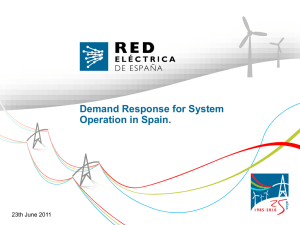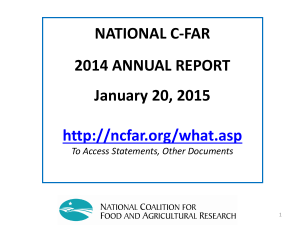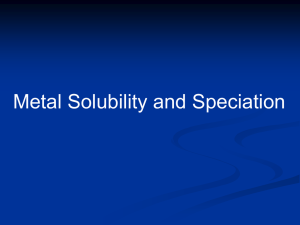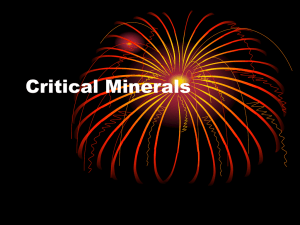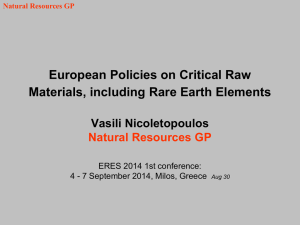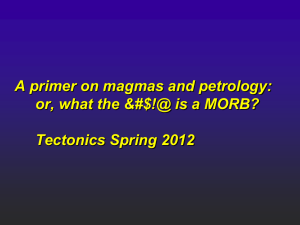REE Deposits
advertisement
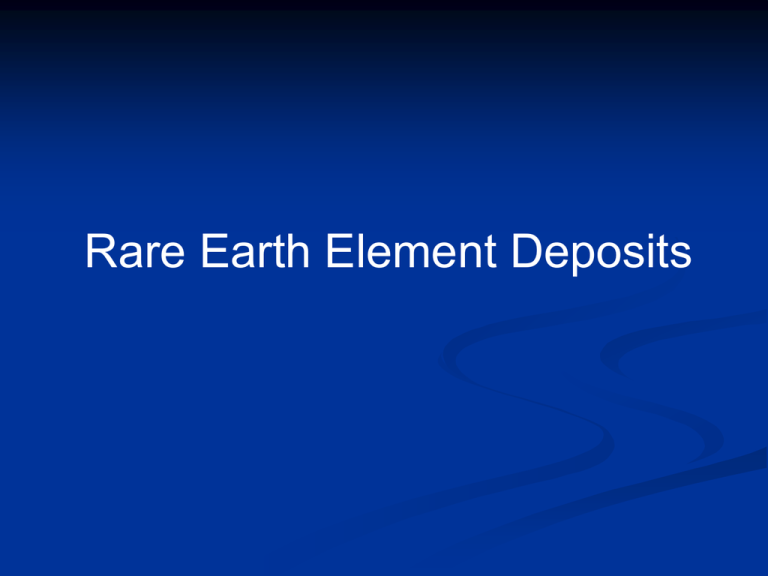
Rare Earth Element Deposits
The REE and the Periodic Table
1
H
Li
3
2
He
4
B
Be
11
12
19
20
21
37
38
39
55
56
57
87
88
89
13
Al
Na Mg
K
5
24
25
26
27
28
29
30
31
41
42
43
44
45
46
47
48
49
72
73
74
75
76
77
78
79
80
81
104
105
106
107
108
109
22
Ca Sc Ti
Rb Sr Y
40
Zr
23
V
Nb Mo Tc Ru Rh Pd Ag Cd In
Re Os Ir
Pt
110
Fr Ra Ac Rf Db Sg Bh Hs Mt Ds
60
14
Si
N
15
P
O
S
8
16
F
9
10
Ne
17
18
36
Cl Ar
32
33
34
35
50
51
52
53
82
83
84
85
61
Au Hg Tl
111
112
Sn Sb Te I
Pb Bi
62
63
64
65
114
Uuu Uub Uuq
66
67
68
69
70
54
Xe
86
Po At Rn
Heavy REE
Light REE
59
C
7
Cr Mn Fe Co Ni Cu Zn Ga Ge As Se Br Kr
Cs Ba La Hf Ta W
58
6
71
Ce Pr Nd Pm Sm Eu Gd Tb Dy Ho Er Tm Yb Lu
The Discovery of the REE
Ytterby and Bastnäs
“Yttria”
Wilhelm Hisinger
Bastnäs
“Ceria”
Ytterby
Johann Gadolin
Ceria and Yttria
Bastnäs (Skarn)
Cerite {Ce9(Fe,Mg)Si7O27(OH)4}
Ytterby (Pegmatite)
Gadolinite {Y2FeBe2Si2O10 }
Cerite
Allanite
Cerite
Gadolinite
Tungsten – heavy stone
1 cm
1 cm
A Use for the REE
In 1885 Auer von Welsbach invents an incandescent mantle, dipping
guncotton in a REE-solution - he had discovered REE-phosphorescence soon his mantles were lighting up the homes, factories and streets of Europe.
He also invented lighter flints – 70% mischmetal, 30% iron
Uses of the REE
Global Production of the REE
China
USA
Other
Relative Abundance of the REE in the Earth’s
Crust Normalized to Primitive Mantle
100
LREE
HREE
HREE
10
1
0.1
La Ce Pr Nd
Sm Eu Gd Tb Dy Ho Er Tm Yb Lu
Y
Major REE Deposits around the World
Nora Karr
Thor Lake
Ilimaussaq
Strange
Lake
Mountain
Pass
Lovozero
Khibina
Bayan Obo
Maoniuping
Lofdal
Steenkampskraal
Browns Ranges
Mount Weld
REE Ore Genesis – the Current State of
Understanding
Effective mineral exploration requires robust models of ore genesis
Understanding
Porphyry/epithermal
Time
Failed Rifts and REE-Rich Magmas
REE/HFSE, volatilerich (H2O,CO2, Cl,
F,) mantle
Low degrees of
partial melting
needed to produce
peralkaline, F-REEHFSE-rich magmas:
carbonatites,
nepheline syenites.
Metasomatised crust
needed to produce
REE/HFSE felsic melts
Strange Lake
Silica-saturated
magma
Crust
Thor Lake
Silica-undersaturated
magma
Felsic magma
Mafic magma
Mantle
The Nechalacho (Thor Lake)
REE Deposit
Cross-Section through part of the
Nechalacho Layered Suite
Long Lake
Upper Zone
Thor Lake
Syenite
Basal Zone
Sodalite Foyaite
Micro-layered Agirine Nepheline Syenite
100 m
Grace Lake
Granite
The Ore Zones
Zrn
Bt
Upper
ore zone
Albitite
Bt, Mt
Basal
ore zone
Unaltered
aegirine
nepheline
syenite
0.5 cm
Bt, Mt
Eud
0.5 cm
Eudialyte
Na15(Ca, REE)6(Fe,Mn)3Zr3NbSi25O72(O,OH,H2O)3
Magmatic concentration of the REE in
Nechalacho Layered Complexes
Residual, volatile
(F, Cl)- and HFSErich magma
saturates with
REE-bearing
zirconosilicates
(zircon, eudialyte)
Sodalite
Crystallisation
from roof down
and floor up
Zr Silicate
Aegirine
Nepheline
The REE “stew in
these juices” and
are mobilised
Hydrothermally Unlocking the REE
Progressive alteration of zircon
Yttrium
Yttrium
Yttrium
Zircon
Fergusonite
20µm
Zirconium
100µm
100µm
Alteration of eudialyte to zircon
and REE minerals
LREE mobilised upwards and
deposited as Bastnäsite-(Ce)
and monazite –(Ce)
HREE deposited locally, mainly
as fergusonite-(Y) {Y,NbO4}
40µm
Yttrium
100µm
Sheard et al. (2012)
The Strange Lake HREE Deposit
REE Reserves
www.questrareminerals.com
The Strange Lake Granitic Pluton
B-Zone
Subsolvus
granite
Hypersolvus
granite
1 km
M-Zone
Hypersolvus
granite
The Strange Lake Pegmatite Ores
Pegmatite border
Gittinsite
(CaZrSi2O7)
Titanite
(CaTiSiO5)
Pegmatite core
REE Minerals
Fluorite
Distribution of REE and Zr in Pegmatite
15
Porous
F
25
Porous
30
Pegmatite
20
Zr
Be
Nb
Ce
Eu
Dy
Y
Hydrothermal Mobilisation of HREE, Zr and Ti
Gadolinite-group
Fluorite
(Ce,La,Nd,Y)2FeBe2Si2O10.
Titanite
K-feldspar
Gittinsite
Qtz
K-feldspar
(CaZrSi2O7)
The Pegmatites Stewed in their
own Juices
Gysi and Williams-Jones (2013)
Magmatic Concentration of REE/HFSE by
Segregation of a late Volatile-rich Melt
Further evolved liquid highly
enriched in incompatible
REE/HFSE and volatiles
Residual liquid enriched in
incompatible REE/HFSE
and volatiles
REE/HFSE
Pegmatites
Crystals
Evolved magma
further enriched in
REE/HFSE
Crystals
Primary magma containing
high concentrations of
REE/HFSE (crystallised)
Melt Inclusions in the Hypersolvus Granite
Melt Inclusions are
evident by their
spherical shape. They
vary from being
silicate-only, to fluoritebearing to fluoride-only.
Vasyukova and Williams-Jones (2014)
Fluorite-bearing Melt Inclusions after
Heating and Quenching
Transmitted Light
1 –Silicate melt
enriched in Zr
2 –Ca-fluoride melt;
10 wt.% REE
SEM Image
3 –REE-fluoride
melt; 50 wt.% REE
Model of REE Accumulation
Zr
Subsolvus
granite
Pegmatite
Ca, REE, F
Porous
Fractional
crystallizatio
n
Fluoride
melt
Silicate
melt
Hydrothermal
fluid
REE
Mobilised
F
Porous
Al, Na, K,
Fe + Zr
cooling
Y
The Bayan Obo REE Deposit, China
Monazite (LREEPO4) and bastnäsite
(LREECO3F), together with magnetite,
hematite and fluorite replaced H8 dolomite .
Fluids 5 – 15 wt% NaCl eq., T > 400 C.
Smith and Henderson (2000)
Pearson’s HSAB Principles and
Aqueous Metal Complexes
Hard acids (large Z/r) bond with hard bases (ionic bonding)
and soft acids (small Z/r) with soft bases (covalent bonding).
Hard
Borderline
Soft
Acids
H+, Na+>K+
Al3+>Ga3+
Y3+,REE3+ (Lu>La)
Mo+6, W+6, U+6
Zr4+,Nb5+
Fe2+,Mn2+,Cu2+
Zn2+>Pb2+,Sn2+,
As3+>Sb3+=Bi3+
Au+>Ag+>Cu+
Hg2+>Cd2+
Pt2+>Pd2+
Bases
F-,OH-,CO32- >HCO3SO42- >HSO4PO43-
Cl-
HS->H2S
CN-,I->BrPearson (1963)
Modelling REE Mineral Solubility in a FBearing Brine
10 wt.% NaCl,
500 ppm F,
200 ppm Nd
The REE are transported dominantly as chloride complexes despite the
greater stability of REE fluoride complexes, because HF is a weak acid
and REE fluoride is relatively insoluble. Migdisov and Williams-Jones (2014)
References
Vasyukova, O & Williams-Jones, A.E., (2014). Fluoride-silicate melt
immiscibility and its role in REE ore formation: Evidence from the Strange
Lake rare metal deposit, Quebec-Labrador, Canada. Geochimica et
Cosmochimica Acta, 139, 110-130.
Gysi, A., & Williams-Jones, A.E. (2013). Hydrothermal mobilization of
pegmatite-hosted REE and Zr at Strange Lake: a reaction path model.
Geochim. Cosmochim. Acta 122, 324-352.
Chakhmouradian A.R. & Zaitsev, A.N. (2012). Rare Earth Mineralization in
igneous rocks.: Sources and Processes. Elements 8, 355-360.
Williams-Jones, A.E., Migdisov, A.A., & Samson, I.M. (2012). Hydrothermal
mobilization of the rare earth elements – a tale of ‘ceria’ and ‘yttria’.
Elements 8, 355-360.
Sheard, E.R., Williams-Jones, A.E., Heiligmann, M., Pederson, C., & Trueman,
D.L. (2012). Controls on the concentration of zirconium, niobium, and the rare
earth elements in the Thor Lake rare metal deposit, Northwest Territories,
Canada. Econ. Geol. 107, 81-104.
